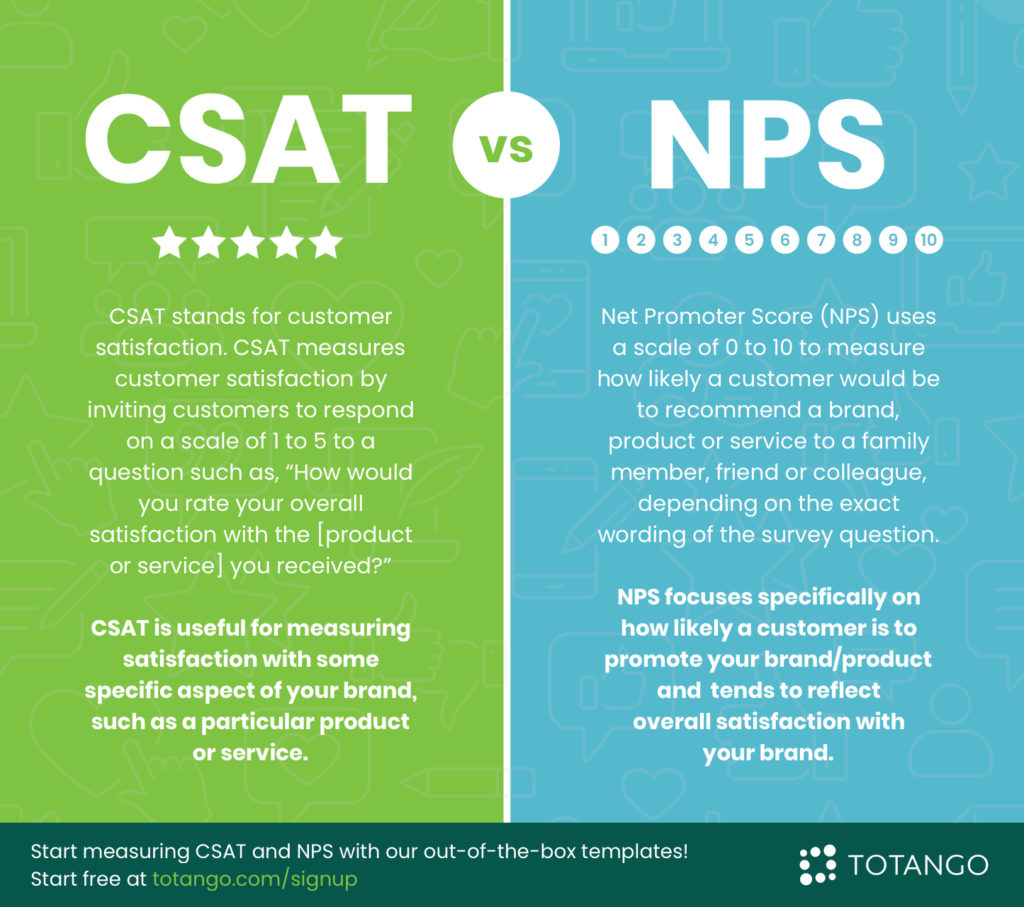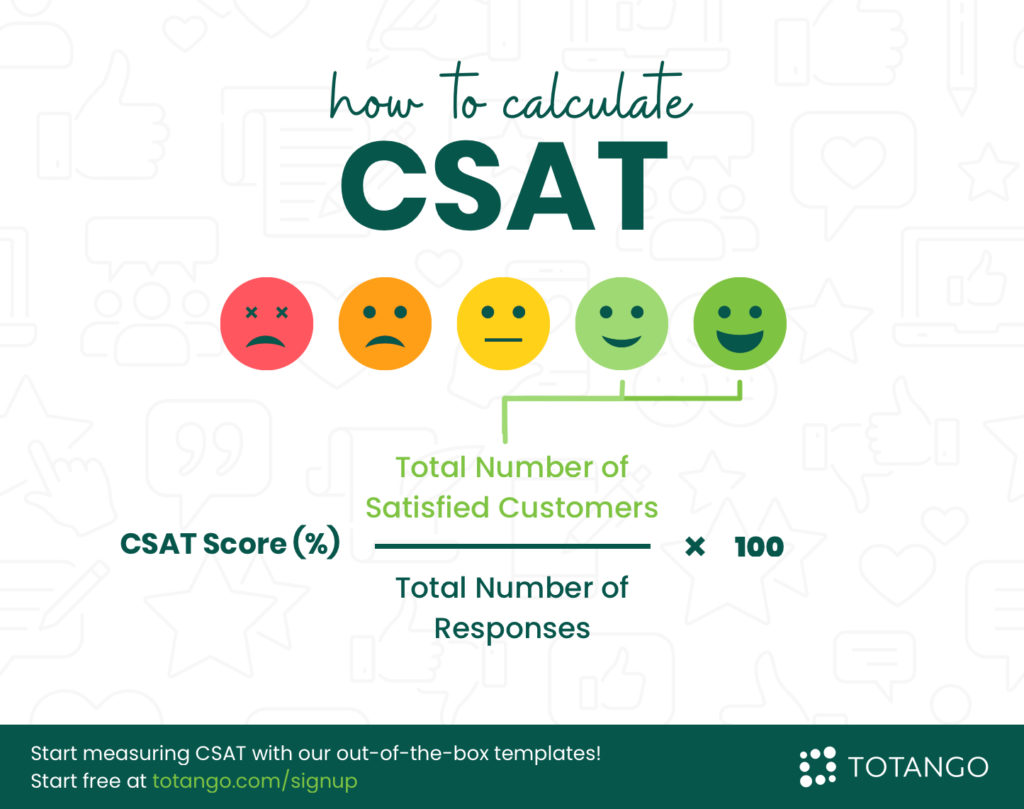What is CSAT, what is it good for and how do you track it and use it? In this post, we’ll focus on this important customer satisfaction metric. We’ll define what it is and how it contrasts with another popular key performance indicator, NPS. We’ll consider the benefits of tracking CSAT and how it can help your business. We’ll discuss how to measure CSAT within the context of your customer lifecycle. Finally, we’ll look at some practical applications of CSAT data and show how technology can help you get the most out of your CSAT data.
What Is CSAT?
CSAT stands for customer satisfaction or, when referred to as a key performance indicator, customer satisfaction score. As a KPI, CSAT measures customer satisfaction by inviting customers to respond to a question such as, “How would you rate your overall satisfaction with the [product or service] you received?” It’s important to note that Totango’s CSAT surveys are transactional, and measure the experience of a specific transaction, engagement or interaction.
Customers respond on a scale of 1 to 5, with 4 indicating a satisfied customer and 5 indicating a very satisfied customer. Scores of 3 are neutral and scores of 2 or 1 represent unsatisfied and very unsatisfied customers. CSAT calculations total up scores of 4 and 5 to measure what percentage of customers are either satisfied or very satisfied. Research has shown that scores in this range correlate highly with customer retention.
CSAT Versus NPS

CSAT shares some similarities with another popular customer satisfaction metric, Net Promoter Score (NPS), as well as some key differences. NPS uses a scale of 0 to 10 to measure how likely a customer would be to recommend a brand, product or service to a family member, friend or colleague, depending on the exact wording of the survey question. Scores of 9 or 10 are isolated to yield a percentage of customers who would be likely to promote recommendations.
Like CSAT, NPS segregates a percentage of positive results from survey results to measure an aspect of customer satisfaction. However, where CSAT focuses directly on customer satisfaction, NPS focuses more specifically on how likely a customer is to promote the brand or product. These two metrics use similar scoring systems to measure different aspects of customer satisfaction. CSAT can be more useful for measuring satisfaction with some specific interactions with your product, while NPS tends to reflect overall satisfaction with your brand and loyalty.
What Are the Benefits of CSAT?
CSAT offers several benefits as a method of measuring customer satisfaction:
- It’s flexible, allowing you to measure customer satisfaction in different areas
- It’s simple, making it easy to administer and track
- It’s short and easy to answer, generating higher response rates than other satisfaction surveys
These benefits help make CSAT one of the more widely used and valued satisfaction metrics.
How Do You Measure CSAT?

To measure CSAT, add up the total value of all replies of 4 or 5. Divide the result by the total number of responses. Convert the answer to a percentage to identify the percentage of customers who are either satisfied or very satisfied with the item which was the subject of the survey.
You can use CSAT to measure different items throughout each stage of your customer journey. For example, you can measure satisfaction with:
- Your purchasing process
- Your onboarding process
- Adoption of a particular software feature
- A customer escalation experience
- Your subscription renewal process
These are just some examples. You can use CSAT to measure satisfaction at a very granular level at any point in your customer lifecycle. Consider setting up automated CSAT surveys to be emailed at key benchmarks in your customer’s experience with your brand. Totango’s Spark platform allows you to set up automatically triggered workflows called SuccessPlays which can be used to automate the process of gathering CSAT data from key points in your customer’s journey.
What Can You Do with CSAT Score Data?
Once you’ve collected CSAT score data, you can leverage it in a number of ways that serve to help you manage and improve customer satisfaction. Internally, you can share CSAT data with relevant members of your team. For example, if your CSAT data indicates dissatisfaction with a certain aspect of your customer support, such as customer wait time, you can pass this information on to your support team in order to take corrective action. Use your CSAT data to scale up areas where you’re achieving high satisfaction and improve areas where you’re not.
Another way you can use CSAT data is by identifying satisfied customers so you can solicit reviews. For example, you can invite very satisfied customers to post on a software review site such as G2. A variation of this strategy is reaching out to customers and asking for case studies.
For customers who provide low scores, after fixing their problem, you can ask them if they’d like to meet with your product team and provide input on how their experience could be improved.
For neutral responses, you can promote more enthusiasm by recommending content, community forums, and knowledge bases that highlight how other people who’ve had similar experiences have enjoyed using your product and interacting with your brand.
Transform CSAT Data into Higher Customer Satisfaction
CSAT provides a quantifiable scale you can use to measure satisfaction with your product or service. It differs from NPS in that it focuses more directly on satisfaction rather than enthusiasm with recommending your brand.
CSAT is simple and easy to track, generating high response rates and clear insights. It is measured on a scale of 1 to 5, with answers of 4 or 5 indicating satisfaction. This can be applied to any stage of your customer journey to gain insight into satisfaction with different aspects of your client’s experience. You can share CSAT data with your team for better satisfaction management or use it to elicit reviews or case studies.
Collecting and leveraging CSAT data to generate higher satisfaction rates is easier when you have the right technology tools. Totango’s Spark platform includes built-in tools for tracking CSAT and other KPIs and triggering data-driven automated workflows which promote more satisfying customer experiences at every stage of your client’s journey. Try it free to experience the benefits of automated customer satisfaction tracking and management.

